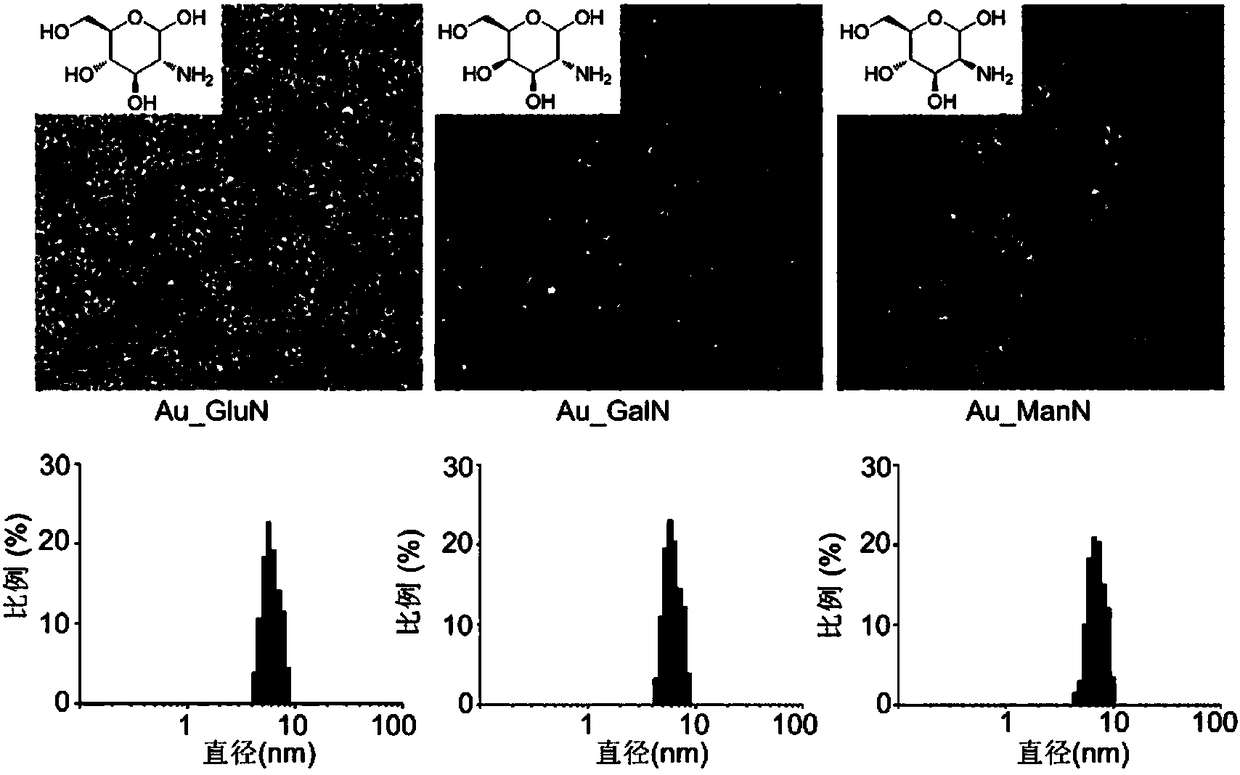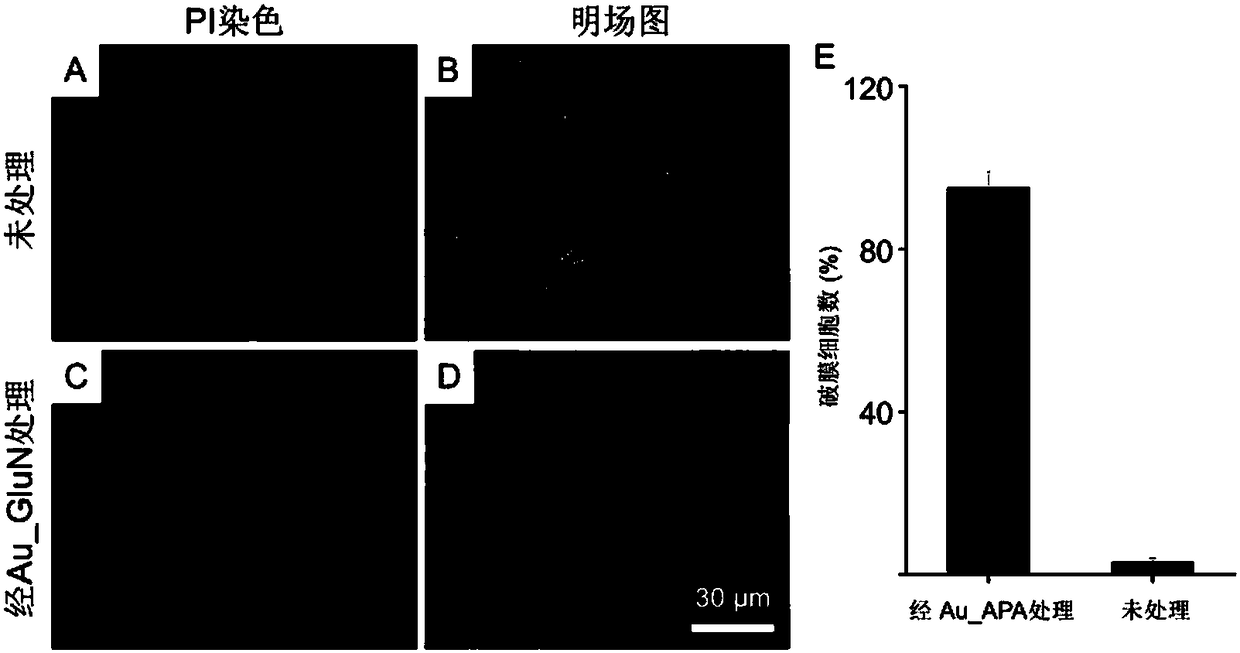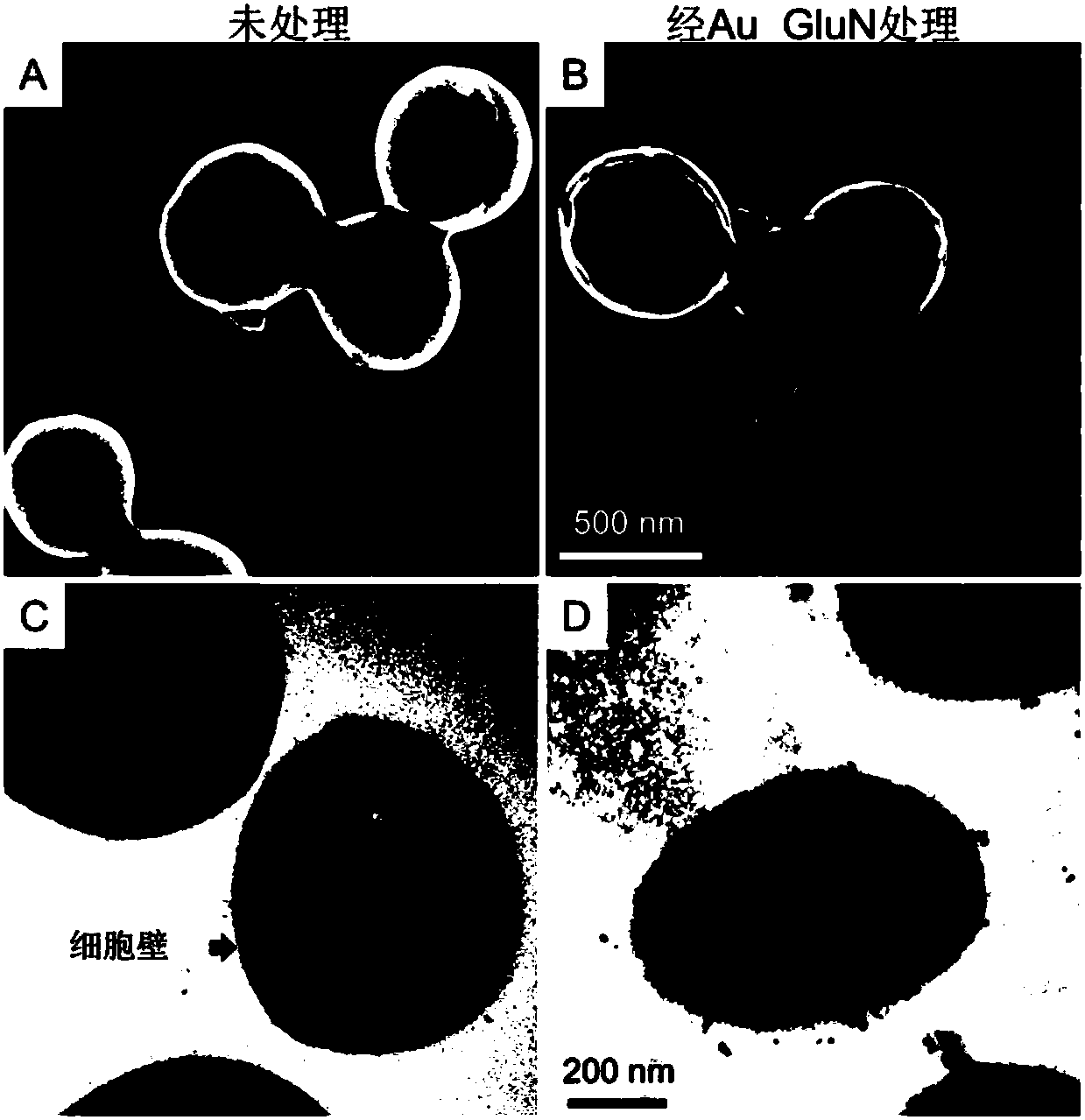Amino sugar modified antibacterial gold nanoparticle and preparation method thereof, and applications
A gold nanoparticle and nanoparticle technology, applied in the field of nanomaterials, can solve the problems of bacterial overgrowth, intestinal microbiota damage, dysbiosis, etc., and achieve the effects of low cytotoxicity, prevention of organ adhesion, and excellent antibacterial properties.
- Summary
- Abstract
- Description
- Claims
- Application Information
AI Technical Summary
Problems solved by technology
Method used
Image
Examples
Embodiment 1
[0068] This example is used to illustrate the synthesis of D-glucosamine (GluN) modified antibacterial gold nanoparticles Au_GluN.
[0069] Dissolve D-glucosamine (GluN) (9 mg, 0.042 mmol) in 6 mL of deionized water, add 50 μL of triethylamine and 20 mg of Tween 80 and mix well, then add HAuCl 4 Solution (41mg, 0.1mmol, dissolved in 1mL deionized water), stirred in an ice-water bath for about 10 minutes, under vigorous stirring (1200rpm) was added dropwise fresh NaBH 4 Solution (6mg, 0.15mmol, dissolved in 2mL deionized water, ready to use, to prevent oxidation). The solution turned brown immediately. The stirring speed was then reduced and stirring was continued for 1 hour in an ice-water bath. The solution was then dialyzed against deionized water (14 kDa MW cutoff, Millipore) for 24 hours, filtered and sterilized through a 0.22 μm filter (Millipore), and stored at 4°C. Nanoparticles of the size figure 1 shown.
Embodiment 2
[0071] This example is used to illustrate the synthesis of D-galactosamine (GalN) modified antibacterial gold nanoparticles Au_GalN.
[0072] Dissolve D-galactosamine (GalN) (9 mg, 0.042 mmol) in 6 mL of deionized water, add 50 μL of triethylamine and 20 mg of Tween 80 and mix well, then add HAuCl 4 Solution (41mg, 0.1mmol, dissolved in 1mL deionized water), stirred in an ice-water bath for about 10 minutes, under vigorous stirring (1200rpm) was added dropwise fresh NaBH 4 Solution (6mg, 0.15mmol, dissolved in 2mL deionized water, ready to use, to prevent oxidation). The solution turned brown immediately. The stirring speed was then reduced and stirring was continued for 1 hour in an ice-water bath. The solution was then dialyzed against deionized water (14 kDa MW cutoff, Millipore) for 24 hours, filtered and sterilized through a 0.22 μm filter (Millipore), and stored at 4°C. Nanoparticles of the size figure 1 shown.
Embodiment 3
[0074] This example is used to illustrate the synthesis of D-mannosamine (ManN) modified antibacterial gold nanoparticles Au_ManN.
[0075] Dissolve D-mannosamine (ManN) (9 mg, 0.042 mmol) in 6 mL of deionized water, add 50 μL of triethylamine and 20 mg of Tween 80 and mix well, then add HAuCl 4 Solution (41mg, 0.1mmol, dissolved in 1mL deionized water), stirred in an ice-water bath for about 10 minutes, under vigorous stirring (1200rpm) was added dropwise fresh NaBH 4 Solution (6mg, 0.15mmol, dissolved in 2mL deionized water, ready to use, to prevent oxidation). The solution turned brown immediately. The stirring speed was then reduced and stirring was continued for 1 hour in an ice-water bath. The solution was then dialyzed against deionized water (14 kDa MW cutoff, Millipore) for 24 hours, filtered and sterilized through a 0.22 μm filter (Millipore), and stored at 4°C. Nanoparticles of the size figure 1 shown.
PUM
| Property | Measurement | Unit |
|---|---|---|
| particle size | aaaaa | aaaaa |
| particle size | aaaaa | aaaaa |
Abstract
Description
Claims
Application Information
 Login to View More
Login to View More - Generate Ideas
- Intellectual Property
- Life Sciences
- Materials
- Tech Scout
- Unparalleled Data Quality
- Higher Quality Content
- 60% Fewer Hallucinations
Browse by: Latest US Patents, China's latest patents, Technical Efficacy Thesaurus, Application Domain, Technology Topic, Popular Technical Reports.
© 2025 PatSnap. All rights reserved.Legal|Privacy policy|Modern Slavery Act Transparency Statement|Sitemap|About US| Contact US: help@patsnap.com



